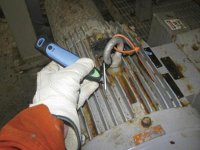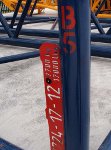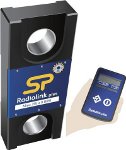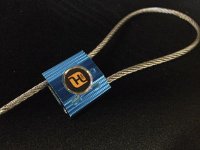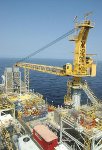Track and trace
27 April 2012Performing regular inspections of equipment is a vital part of keeping lifting operations safe, and complying with standards and regulations. This can only be done if you know when each piece of equipment was last checked. Increasingly, RFID and other ID technologies are making tracking of equipment easier to manage.
CoreRFID
CheckedOK by CoreRFID, a UK based supplier of RFID based solutions, provides computer-guided equipment for safety checks and reports on crane parts and rigging.
While mainly marketed for mobile cranes, the system could just as easily be used in overhead applications, says CoreRFID.
By partially automating the manual inspection process, CheckedOK helps lifters meet LOLER, and PUWER legislation and LEEA best practice requirements for equipment inspection more rapidly and accurately, saving administration costs and improving safety.
It functions partly in the office and in partly in the field. In the office administrators using CheckedOK identify what needs to be inspected using a webaccessible browser for administration, management and reporting, and can then assign the tasks to an engineer who downloads the to-do list to a hand-held computer. The system can be used to match qualified inspectors with the kind of inspection they are qualified for, ensuring that inspections are only conducted by qualified inspectors.
In the field, inspectors use handheld computers to identify objects usually bearing a tag and/or a barcode sticker. CheckedOK can use a selection of different tags, equipment labels, barcodes or radio frequency (RFID) tags to identify lifting equipment and lifting tackle.
Often objects are fitted with tag-based identification in addition to labels in case a label is obscured, a tag is damaged or the stamp wears away.
A list of inspection tasks are assigned for each particular item according to COSHH, DSEAR, LOLER, PUWER or LEEA guidelines.
The information uploads wirelessly to the database and notifies users of failed items. The status of the system can be checked either at a computer or remotely using a web browser. Asset owners have access to a private web portal.
CheckedOK software produces printable reports and certificates not only on asset faults and history, but also the duration of the checks for billing engineer's time.
Reports can be modified to incorporate data from handheld mobiles such as camera, video and GPS.
Field ID
Field ID announced last November that it had enhanced its cloudbased safety compliance management software by including safety scoring.
Manufacturers, distributors, third party inspectors and end users worldwide use Field ID to inspect facilities and equipment, improve training management, and track assets such as cranes, slings and harnesses. Field ID's producer has unveiled a safety inspection and audit scoring feature allowing easy customisation of the software for companies' differing safety scoring processes.
Previously Field ID's scoring for each criteria used a pass-fail system suitable for meeting the needs of most businesses. However, many inspectors use complex systems, such as sliding numeric scales and checklists, to place greater weight on critical safety measures. Field ID now provides sliding scales and automatically calculates scores according to the weighting specified
by users. The new feature allows users to set up a customized scoring system, either on their own or with assistance from Field ID's support team.
The entire customisation process takes no more than five to ten minutes, Field ID says.
Matthew Paterson, Field ID's director of product management explained that the new upgrade shows the company's responsiveness to user requests.
Field ID's inspections branch, N4 Systems, also provides mobile crane inspections in the local Toronto area, and Field ID is adapted to include crane inspection data. The crane inspection part of the software records a vast amount of detail required in a crane inspection incorporated in a simple user display, Field ID says. It was developed in the field with crane inspectors to ensure
features do not get in the inspector's way.
Geoforce
Geoforce, a US-based provider of asset management solutions, offers a Geoforce GPS solution for offshore cranes. It's a combined software and hardware system that uses RFID devices, cellular-based GPS tags and satellite-based GPS tags.
Geoforce has the largest satellite deployment in the Gulf of Mexico and is the only GPS company dedicated to the oil and gas industry, it says.
The oil and gas industry uses cranes and rigging that is left in the field for months or years at a time, with much of the equipment leased from third-party companies and operated by contractors. Employees often work alone in remote locations, with limited access to traditional communication technologies.
When cranes are equipped with GPS tags, they're trackable via global satellite and cellular networks through Geoforce's enterprise grade platform and APIs to feed Geoforce's web-based software application. The system can also be used for realtime monitoring. "Fleet managers can have a simple visual snapshot of the current location of all of their cranes globally and whether or not maintenance is due," Geoforce said.
Geoforce's software provides location mapping with oil lease, rig and well location information to easily provide reporting on the crane's usage.
Geoforce explained the multiple uses of the software's reporting system. "Usage reports can track the number of hours a crane has run remotely to provide accurate billing verification or cost allocation.
"The data generated by these solutions can help reduce the risk of unscheduled downtime, equipment failures, accidents,regulatory compliance violations, and employee injuries.
"Inspection reports can be linked to the assets, creating an electronic audit trail to speed through logistics and handling. Since the same system tracks the location of all equipment, inspectors know where something is to take immediate action."
Geoforce's solution improves tracking not only for cranes, but also for containers, baskets, vehicles, lone workers, generators, boxes, light plants, chemical containers, oil spill equipment, rail cars and emergency response equipment.
Holland 1916
RFID tag manufacturer Holland 1916's most recently released RFID tag is the RFID Data Cinch. The Data Cinch is a rugged, metal cable tie that is zipped on to an asset.
The tie can be incorporated into an inspection and recertification scheme to prevent the high costs, severe injury, and fatality caused by equipment failure.
It is intended to replace and improve the manual inspections system where inspectors perform re-certification on paper, and must later enter the data on a computer.
The tie has a pull strength of over 450kg, making it permanently affixed to the asset.
While some tags require application with tools, the Data Cinch can be fixed by hand rapidly.
"If a customer has a large fleet of assets they want to permanently RFID enable, but don't have the resources to spend a couple minutes per asset applying the tags, the Data Cinch is a great solution," says Holland 1916.
The RFID Data Cinch can be scanned with handheld scanners and used with simple software.
The RFID tag instantly identifies the asset and automatically populates the screen with a digital
inspection form purposed for that exact asset.
An inspector can tap on a few dropdown boxes and check boxes to record the results of the inspection.
When the inspection is complete, the inspector simply syncs the handheld by internet connection and information is immediately updated to the database.
The end user receives immediate updates on the recertification and general safety compliance of their fleet of assets online. To assist clients with applications in extreme environments, Holland 1916 can create custom RFID tag solutions designed to address a number of challenges, and manufacture them to specification.
Idblue
Idblue is introducing its next-generation UHF mobile RFID reader, called "Idblue.UHF", for Smartphones and Tablets.
Idblue, based in St. John's, Canada, is a provider of HF and UHF RFID Bluetooth readers for smartphones and tablets. In the past Idblue inspection systems have been used for infield asset management in oil and gas as well as applications inhealthcare, retail, utilities, aerospace, and other industries.
Idblue.UHF is a handheld, pen-shaped RFID reader designed for equipment such as iPhones and iPads, suitable for closeproximity RFID scanning.
The readers are intended to conform to the globally applicable Electronic Product Code Gen 2 standard for UHF devices.
Weighing less than an apple, just 60g, Idblue.UHF is highly portable and fits into a pocket. The pen style shape of Idblue.UHF has several advantages.
It allows use of the system when the user is wearing gloves, as the specially designed tip of the reader may be used to navigate and enter data on a smartphone.
"Idblue.UHF bridges the gap between the explosion in smartphone use and the rapid growth of RFID adoption," says Steve Taylor, CEO of Idblue.
"As companies increasingly integrate smartphones and tablets into their operations, Idblue turns these devices into a powerful asset tracking and management tool with a value-added RFID reader that seamlessly extends the capabilities of their smartphone infrastructure."
Taylor adds: "The efficiencies enabled by RFID technology are more accessible than ever with our reader's cost-effective UHF design, smartphone compatibility and intuitive interface."
Idblue.UHF gives interested companies the opportunity to try the reader on a 30-day free trial. Companies interested in becoming resellers are invited to apply to Idblue's new SMART (Strategic Market Alliance Reseller Team) Program.
Straightpoint UK
Straightpoint UK, load cell and force measurement equipment manufacturer, provides its RFID-equipped Radiolink Plus range of load cells to an international market.
The company has recently introduced a tag to all its 'link' style load cell products, allowing inspection records to be wirelessly transferred from the product onto a secure database on an office computer.
It says it is the first load cell company to offer RFID tagging incorporated within its products.
The load cells are calibrated in metric tonnes, but may be supplied with alternate calibrations on request.
The process stores an ID number, product type, in-service date, date of last recorded inspection and the status of the product at the last recorded inspection, making records more accurate and saving time compared to completing manual records.
Load cells incorporating RFID tagging can be scanned with the Crosby handheld device and free software program to transfer the data.
Director of Straightpoint UK, David Ayling said: 'The RFID tag system reduces the total inspection process time up to 65% and eliminates errors from handwritten or manual typed inspection reports".
Use of the tag and Crosby handheld device can be incorporated in a maitenance plan with other Crosby RFID tagged products, such as slings or shackles. Ayling explained that the radiolink is now offered with longer batter life. "We've also been busy working on enhancing one of our top-selling products, which is now finalised -- the Radiolink Plus product has been recently upgraded to have 1600 hours of battery life (previously it was 850 hours) due to new battery technology and its clever 'sleep' mode when not in use, so there's no need to charge it every night. The product is proving very popular with on and offshore-related businesses.
We have recently supplied several of these new models for use on dock-side cranes due to its extended battery time, remote control operation and the ability to safely hang it from the hook of crane to accurately test the weight of containers before being loaded onto boats heading for offshore rigs"
Crosby Europe's sales and marketing director Richard Oldknow, said: "I welcome the steps taken by Straightpoint to harness the power of RFID and further strengthen Crosby's Quic Check system as a valuable inspection tool."
Hampshire-based Straightpoint UK supplies crane scales as well as tension and compression loadcells to organisations in the UK and has 22 global distributors.
